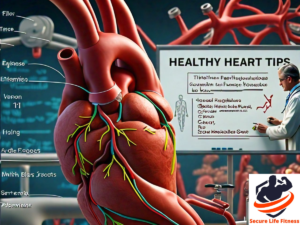Table of Contents
ToggleCardiovascular Chronicles:
The heart, a marvel of biological engineering, serves as the lifeline of the human body, tirelessly pumping blood to every cell, tissue, and organ. As the cornerstone of cardiovascular health, the heart plays a pivotal role in maintaining overall well-being and vitality. However, in today’s fast-paced world marked by sedentary lifestyles, poor dietary choices, and increasing stress levels, heart disease has emerged as a leading cause of morbidity and mortality worldwide. In this comprehensive exploration, we embark on a journey through the Cardiovascular Chronicles, delving into the intricate science of heart health, understanding the risk factors for cardiovascular disease, and uncovering evidence-based strategies for prevention and management.
The Anatomy and Physiology of the Heart
Before delving into the complexities of heart health, it’s essential to understand the anatomy and physiology of the heart. The heart is a muscular organ located in the chest cavity, slightly left of the midline, and is divided into four chambers: the right atrium, right ventricle, left atrium, and left ventricle. These chambers work in concert to pump oxygen-rich blood to the body and oxygen-depleted blood to the lungs for reoxygenation. The heart’s rhythmic contractions, orchestrated by a specialized conduction system, ensure efficient blood circulation and nutrient delivery to all tissues.
Risk Factors for Cardiovascular Disease
While genetics play a role in predisposing individuals to cardiovascular disease, lifestyle factors exert a profound influence on heart health. Key modifiable risk factors for cardiovascular disease include:
Poor Diet:
Diets high in saturated fats, trans fats, cholesterol, sodium, and refined sugars can contribute to the development of atherosclerosis, hypertension, and obesity, increasing the risk of heart disease.
Sedentary Lifestyle:
Lack of physical activity is associated with obesity, insulin resistance, dyslipidemia, and hypertension, all of which are risk factors for cardiovascular disease.
Smoking:
Tobacco smoke contains numerous toxic chemicals that damage blood vessels, promote inflammation, and increase the risk of atherosclerosis, heart attack, and stroke.
High Blood Pressure:
Hypertension, or high blood pressure, forces the heart to work harder to pump blood, leading to cardiac hypertrophy, heart failure, and increased risk of cardiovascular events.
Diabetes:
Uncontrolled diabetes accelerates atherosclerosis, impairs blood vessel function, and predisposes individuals to coronary artery disease, peripheral artery disease, and stroke.
Obesity:
Excess body weight, particularly visceral fat, is associated with insulin resistance, dyslipidemia, inflammation, and other metabolic abnormalities that increase the risk of heart disease.
Understanding these risk factors is paramount for implementing preventive measures and promoting heart-healthy behaviors in individuals at risk for cardiovascular disease.
The Science of Prevention and Management
Fortunately, many strategies exist for preventing and managing cardiovascular disease, ranging from lifestyle modifications to pharmacological interventions. Here are some evidence-based approaches:
Healthy Diet:
Adopting a heart-healthy diet rich in fruits, vegetables, whole grains, lean proteins, and healthy fats can lower cholesterol levels, reduce blood pressure, and improve overall cardiovascular health.
Regular Exercise:
Engaging in regular physical activity, such as aerobic exercise, strength training, and flexibility exercises, can strengthen the heart, improve blood flow, and lower the risk of heart disease.
Smoking Cessation:
Quitting smoking is one of the most effective ways to reduce the risk of cardiovascular disease and improve overall health. Numerous resources and support programs are available to help individuals quit smoking successfully.
Blood Pressure Control:
Monitoring blood pressure regularly and taking steps to lower elevated readings, such as medication adherence, dietary modifications, stress management, and regular exercise, can reduce the risk of heart disease and stroke.
Diabetes Management:
Controlling blood sugar levels through medication, dietary changes, regular exercise, and weight management is essential for preventing diabetes-related complications and reducing the risk of cardiovascular disease.
Weight Management:
Achieving and maintaining a healthy weight through calorie control, portion control, regular exercise, and behavior modification can improve cardiovascular risk factors and overall health.
In addition to lifestyle modifications, pharmacological interventions, such as statins, antihypertensive medications, antiplatelet agents, and anticoagulants, may be prescribed to individuals at high risk for cardiovascular events.
Conclusion
The Cardiovascular Chronicles have shed light on the intricate science of heart health, from the anatomy and physiology of the heart to the risk factors for cardiovascular disease and evidence-based strategies for prevention and management. While heart disease remains a formidable adversary, armed with knowledge, awareness, and proactive measures, individuals can take control of their heart health and embark on a journey toward a longer, healthier life. By embracing heart-healthy habits, fostering a supportive environment, and partnering with healthcare professionals, we can rewrite the narrative of cardiovascular chronicles disease and pave the way for a healthier, heartier future.
ALSO:














